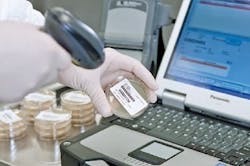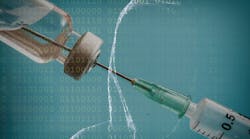Manufacturers of biotherapeutics and medical devices must perform a wide range of quality controlmicrobiology tests to ensure both products and clean room manufacturing facilities meet strict regulatory guidelines on contaminant control. The recent rapid growth in the number of these sterile products entering the market means that increased regulatory attention is now being paid to how QC data is collected, managed and stored. Many laboratories still rely on paper-based environmental monitoring approaches, however, these are prone to human error and often require considerable amounts of time to collect and interpret this information. In this article, we look at how the latest paperless systems are improving the reliability and effectiveness of environmental monitoring from a QC microbiology perspective, and how this technology can seamlessly integrate with laboratory information management systems (LIMS) to bridge the communication gap between QC and product manufacture.
THE NEED FOR STERILE MANUFACTURING ENVIRONMENTS
Combining environmental monitoring systems with LIMS enables QC microbiology labs to analyze and share test results in real time, allowing manufacturers to take corrective and preventative action at the earliest opportunity.
Microorganisms such as bacteria, fungi and mold can be found everywhere: in the air, in water, on surfaces, and on our clothes, hair and skin. But the presence of even trace amounts of these biological contaminants in biotechnology products, such as biological medicines and medical devices, can significantly impact drug efficacy and device performance and can have serious consequences for patient health. Bacterial endotoxin contamination in parenteral pharmaceuticals and implantable devices, for instance, can result in life-threatening conditions such as septic shock if accidentally introduced into a patient’s cardiovascular or lymphatic systems. Even endotoxins from dead bacterial cells introduced to the product during the manufacturing process can compromise patient safety when used clinically.To minimize the risk of contamination, the FDA requires manufacturers to demonstrate that production and packaging facilities and representative product samples are free from these types of contaminants. To do this, regular sampling of the laboratory environment must be undertaken. And because microorganisms can contaminate a wide variety of surfaces and environments, an extensive range of samples must be collected, from air and water specimens through to surface swabs of benchtops, instruments and personal protective equipment. These samples — often numbering in the thousands per month — are incubated on agar plates and analyzed for microbial growth.
Many laboratories still use paper-based systems to schedule the sampling process and manage the collection of this environmental data. However, with such a large volume of samples to be taken, organizing, retrieving and interpreting this information can be challenging.
Paper-based systems are inherently inefficient and not ideally suited to the demands of sterile manufacturing environments. All materials, including paper, must first be sterilized before entering the clean room, adding additional, time-consuming stages to data-collection workflows. When you also consider that paper records and worksheets must often be manually logged into spreadsheets for data to be shared or analyzed, it becomes clear that paper-based systems unnecessarily burden laboratory workloads and are more prone to errors. And with an increased regulatory focus on data integrity, paper-based workflows simply don’t provide the level of accuracy, traceability and completeness that regulatory authorities demand.
PAPERLESS SOLUTIONS OFFER ENHANCED DATA INTEGRITY
Purpose-built electronic environmental monitoring systems overcome many of the limitations associated with paper-based approaches. The latest paperless environmental monitoring systems possess a number of features that make QC testing more convenient for users, while helping laboratories reach the highest levels of data integrity and meeting regulatory guidelines.
Using paperless systems, measurements of incubation temperature or pH can be taken directly using probes that can be connected to the device, minimizing the potential for human error and ensuring data collection is always accurate. Electronic systems can further reduce errors by guiding users through data-collection protocols, preventing process deviations and prompting users to complete missing information prior to submission in ways that paper-based approaches cannot enforce. These systems can help ensure laboratories comply with regulatory guidelines by recording all necessary measurements according to standard operating procedures.
With a wide range of locations and samples to test, environmental monitoring systems for QC microbiology must be mobile. Lonza’s MODA-EM system, for instance, is built using robust hardware that can withstand regular sterilization, while allowing users to move between data collection points around the clean room. Systems based on printed barcode labeling — made possible through the use of easily sterilized label printers and portable barcode readers — can help make data collection quick and convenient for users, while ensuring data is accurate, organized and traceable.
REAL TIME DATA ANALYSIS FOR A RAPID RESPONSE
With patient safety of primary concern for biotechnology manufacturers, the discovery of laboratory or batch contamination can cause significant and costly disruption to production workflows — not to mention possible regulatory action or reputational damage. By combining environmental monitoring systems with LIMS, such technology enables QC microbiology laboratories to analyze and share test results in real time, allowing manufacturers to take corrective and preventative action (CAPA) at the earliest opportunity.
Through powerful data analysis and visualization software, electronic environmental monitoring systems can help laboratories identify the source of potential contamination more quickly. Systems are available that can track and trend data such as microorganism levels based on a range of sampling parameters, including location, employee, batch or any combination thereof. The results of subsets of tests can be quickly correlated over specified time periods, facilitating rapid investigation of non-standard results.
Automated, electronic monitoring systems also ensure CAPA workflows are enforced when expected operating parameters are breached. For instance, the detection of bacteria on a laboratory surface or in a particular product can automatically trigger a new workflow to investigate and resolve the issue. Such systems ensure issues are investigated according to standard procedures and are properly documented. Not only does this prevent affected products reaching patients, it can also prevent similar incidents from occurring in the future. With regulatory authorities increasingly looking at the way in which laboratory data is collected and stored, paperless monitoring systems that enforce user compliance ensure that the necessary data is always available at the click of a button.
BRIDGING THE GAP BETWEEN QC AND PRODUCTION WORKFLOWS
Whether production and QC teams are located at a single manufacturing site or collaborate between multiple facilities, it’s vital that decision makers have access to the information needed to safeguard product quality. By sharing QC data on representative batch samples, users from all parts of the value chain can gain timely access to relevant information on product or environmental QC in advance of batch release. Using a monitoring system that can seamlessly integrate with the often disparate LIMS used by different teams can therefore help to bridge the communication gap between manufacturing and QC and improve organizational efficiency.
In bacterial endotoxin testing, for example, LIMS can schedule the testing of product batches by the QC microbiology laboratory, and alert the manufacturer to the outcome or status of these tests prior to product release. With real-time QC tracking, changes in the production process that affect product quality or sources of contamination can be rapidly identified and corrected. Comparisons of product quality between manufacturing sites can also be made, ensuring consistency across the organization.
MEETING MICROBIOLOGISTS' NEEDS
While there are many advantages to integrating electronic environmental monitoring systems with LIMS, many off-the-shelf LIMS packages are built with batch-control chemistry rather than QC microbiology in mind. These systems often cannot meet the business requirements for managing the entire microbiological workflow, the frequency of sample collection or the volume of testing required. Additionally, batch-focused LIMS are not well suited to interpreting the location-based sampling approaches that form an essential component of QC microbiology testing. Many commercially available LIMS packages therefore often require considerable and costly customization in order to meet the needs of microbiologists.
Some systems designed specifically for microbiologists include user interfaces that can actually map the clean room and the data collection points within it. These interfaces more clearly visualize the status and outcomes of tests, helping to pinpoint the source of any potential contamination more rapidly and make identifying outstanding tests easier. Additional features, such as conditional logic-based limits that can alert users or perform actions depending on whether a limit has been reached a specified number of times over a certain time period, are also very useful for microbiology applications.
Being able to perform offline data collection is also an advantage for microbiologists who use clean room laboratories where Wi-Fi connectivity is not necessarily available. This feature gives users the freedom to collect data contemporaneously in a range of sampling locations, unlike many off-the-shelf LIMS that require online connectivity at all times.
AN INTEGRATED FUTURE
Electronic environmental monitoring systems offer a more accurate, convenient and efficient way for manufacturers of medical devices and biotherapeutics to perform QC microbiology testing than conventional paper-based approaches. The incorporation of such systems into QC microbiology workflows allows manufacturers to demonstrate their products and sterile production environments comply with regulatory guidelines, and ensure that corrective and preventative action is automatically taken when expected operating parameters are breached. Integrating these monitoring systems with LIMS can give manufacturers timely access to information relating to batches undergoing QC microbiology testing, helping to bridge the communication gap between QC and production. These paperless workflows can improve process efficiency and save valuable time and resources, and help manufacturers ensure patient safety is never compromised.






